The effect of feeding zeolite A during the prepartum period on serum mineral concentrations in multiparous Holstein Cows
Published: July 19, 2018
By: A. L. Kerwin*, C. M. Ryan*, B. M. Leno*, M. Jakobsen †, P. Theilgaard‡, and T. R. Overton*
*Department of Animal Science, Cornell University, Ithaca, NY, USA
† Protekta Inc., Lucknow, Ontario, Canada
‡ Vilofoss, Graasten, Denmark
Introduction
- Most cows undergo some level of hypocalcemia in the immediate postpartum period, with 40 to 70% of multiparous cows developing subclinical hypocalcemia (SCH; Reinhardt et al., 2011; Caixeta et al., 2015; Neves et al., 2017).
- Feeding prepartum rations low in Ca can improve Ca status postpartum (Kichura et al., 1982) but is difficult to achieve with commonly used feedstuffs in the US (Goff, 2006).
- In European studies, feeding zeolite A for the 2 weeks prior to calving has been shown to bind to dietary calcium and improve blood Ca status in the days following parturition (Thilsing et al., 2006; Pallesen et al., 2008). Effects of this feeding strategy in a 3 wk prefresh program have not been demonstrated.
Objective
- To determine the effect of feeding multiparous Holstein cows synthetic zeolite A for 3 wk prior to expected calving on peripartum serum mineral status.
Materials & Methods
- 55 multiparous Holstein cows (2nd lactation = 24, 3rd+ lactation = 31) were enrolled 28 d prior to expected calving and randomly assigned to 1 of 2 dietary treatments (trt) starting at 21 d prior to expected calving;
- Control (CON; n = 29) – 40% CS, 33% wheat straw, and 27% concentrate mix
- Experimental (EXP; n = 26) – CON diet with the addition of synthetic zeolite A (XZelit, Protekta Inc., Lucknow, Ontario, CA/Vilofoss, Graasten, DK) at 3.3% of DM, targeting 500 g/d as fed
- Blood was collected 1x/wk from enrollment until 7 d prior to expected calving, daily from 7 d prior to expected calving until 7 DIM, 3x/wk from wk 2-4, and 2 samples collected within 24 h of calving and a subset were analyzed for Ca, P, and Mg concentrations.
- Prepartum and postpartum data were analyzed separately. Data analyzed over time were subjected to repeated measures ANOVA using the MIXED procedure in SAS v.9.4, the REPEATED statement for time, and P values were corrected for multiple comparisons using Tukey HSD. Least squares means and standard errors are reported.
- Fixed effects were trt, time, parity (2nd vs. 3rd+), all 2-way interactions, and random effect was cow within trt.
- The difference in prevalence of SCH between trt x d was tested with Fisher’s exact test.
Results
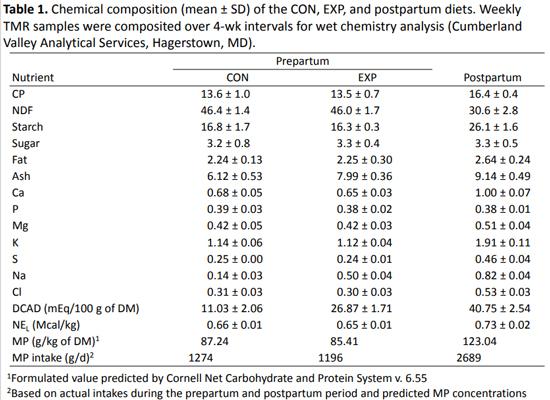
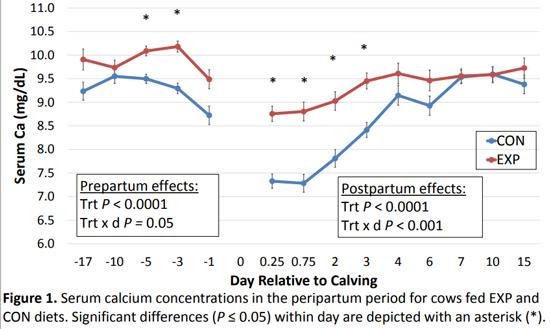
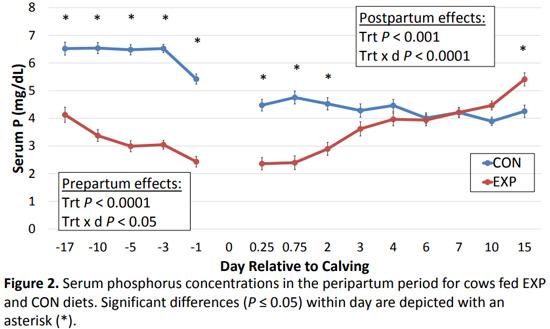
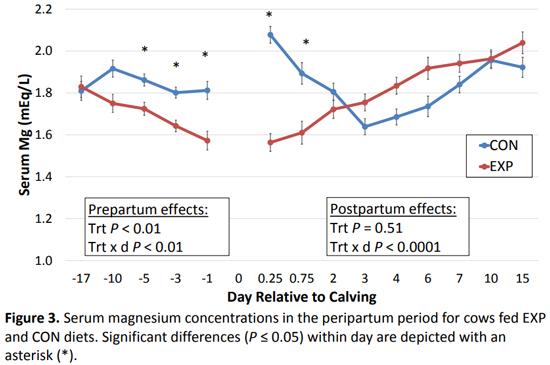
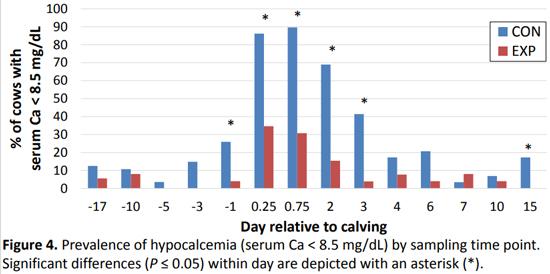
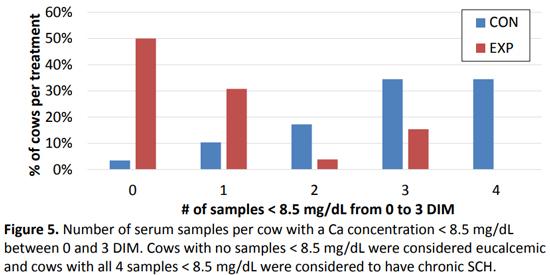
Conclusions
- Serum Ca concentrations were higher for cows fed EXP compared to CON during both prepartum and postpartum periods; differences were greatest during the immediate periparturient period.
- Serum P concentrations were lower for cows fed EXP compared to CON during both prepartum and postpartum periods; differences were greatest prepartum and during the immediate postpartum period.
- Serum Mg concentrations were lower for cows fed EXP compared to CON during the prepartum and immediate postpartum periods.
- The prevalence of SCH in cows fed EXP was lower than cows fed CON during the immediate periparturient period and cows fed EXP did not experience chronic SCH while 35% of CON fed cows were affected.
- Normal Ca concentrations (≥ 8.5 mg/dL) were maintained in 50% of EXP fed cows from 0 to 3 DIM compared to 3% of CON fed cows.
- Supplementing synthetic zeolite A for 3 wk before expected parturition resulted in improved Ca status around calving yet it is unclear as to the biological impact of reduced P and Mg concentrations around calving.
Acknowledgements
We would like to thank Protekta Inc. and Vilofoss for financial support of this project.
References
Caixeta, L.S., P.A. Ospina, M.B. Capel, and D.V. Nydam. 2015. The association of subclinical hypocalcemia, negative energy balance and disease with bodyweight change during the first 30 days post-partum in dairy cows milked with automatic milking systems. Vet. J. 204:150–156. doi:10.1016/j.tvjl.2015.01.021.
Goff, J.P. 2006. Macromineral physiology and application to the feeding of the dairy cow for prevention of milk fever and other periparturient mineral disorders. Anim. Feed Sci. Technol. 126:237–257. doi:10.1016/j.anifeedsci.2005.08.005.
Kichura, T.S., R.L. Horst, D.C. Beitz, and E.T. Littledike. 1982. Relationships between prepartal dietary calcium and phosphorus, vitamin D metabolism, and parturient paresis in dairy cows. J. Nutr. 112:480–487.
Neves, R.C., B.M. Leno, T. Stokol, T.R. Overton, and J.A.A. McArt. 2017. Risk factors associated with postpartum subclinical hypocalcemia in dairy cows. J. Dairy Sci. 100:3796–3804. doi:10.3168/jds.2016-11970.
Pallesen, A., F. Pallesen, R.J. Jørgensen, and T. Thilsing. 2008. Effect of pre-calving zeolite, magnesium and phosphorus supplementation on periparturient serum mineral concentrations. Vet. J. 175:234–239. doi:10.1016/j.tvjl.2007.01.007.
Reinhardt, T.A., J.D. Lippolis, B.J. McCluskey, J.P. Goff, and R.L. Horst. 2011. Prevalence of subclinical hypocalcemia in dairy herds. Vet. J. 188:122–124. doi:10.1016/j.tvjl.2010.03.025.
Thilsing, T., R.J. Jorgensen, and H.D. Poulsen. 2006. In vitro binding capacity of Zeolite A to calcium, phosphorus and magnesium in rumen fluid as influenced by changes in pH. J. Vet. Med. Ser. A 53:57–64. doi:10.1111/j.1439-0442.2006.00798.x.
Vilofoss presented the X-Zelit posters at the ADSA Meeting 2018
Content from the event:
Related topics:
Authors:
Vilofoss
protekta
Recommend
Comment
Share

Would you like to discuss another topic? Create a new post to engage with experts in the community.










